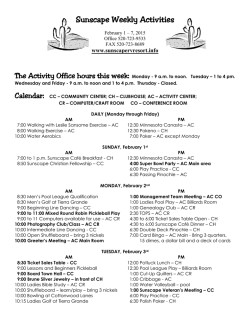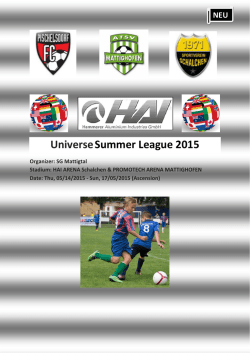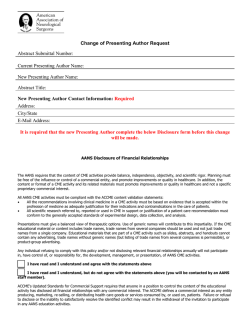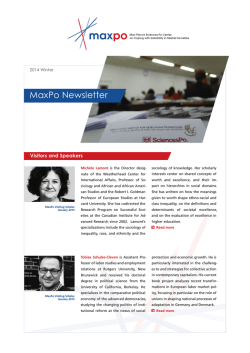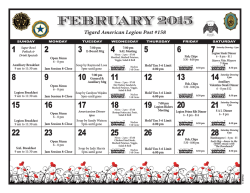
CANS January 2015 Newsletter - Council of State Neurosurgical
California Association of Neurological Surgeons Volume 43 Number 1 January 2015 President's Letter Phillip Kissel, MD, CANS 2015 President Dear Fellow CANS Members, The new year is upon us and your CANS organization has already launched an agenda for 2015. Building on four decades of infrastructure, Dr. Deborah Henry has completed a productive year at the helm and has reinvigorated the committees and consultants that advise the board of directors. The Orange county meeting was superb with representation from all sectors of neurosurgical spanning both the state geography and many practice and employment models. There was an excellent exchange of ideas and concepts which has continued to keep CANS relevant in a complex and dynamic practice environment. We welcome new members to the organization: Dr. Marvin Bergsneider, Dr. Jefferson Chen, Dr. Valdimir Cortez, Dr. Jennifer Jennings, Dr. Linda Liau and Dr. Philip Theodosopoulos. I would remind and encourage any interested member to attend a tri-annual meeting of the board of directors. This is a great forum to present any observations or concerns about the socioeconomic situations we all face in our day-to-day practices. Please contact our executive secretary Emily Schile at [email protected] for specific meeting dates and adding a discussion item on the agenda. The year ahead looks both stimulating and challenging. We will continue representing California Neurosurgery at both the National and State levels. We are committed to championing the socioeconomic aspects of neurosurgical practice from residency to retirement. I quote a recent past president: “CANS is the only voice for neurosurgeons on major issues in California. If CANS has no opinion, there will be no voice for California Neurosurgery.” No organization can exist without an income stream. CANS is no exception. Its solvency is predicated on the members paying their annual dues. We are redoubling our efforts to collect these monies in a timely fashion to assist in projecting the year’s budgetary constraints. This is a voluntary and nonprofit entity which cannot move forward without everyone’s monetary support. I urge all of you to renew your membership ASAP. The monthly newsletter is an excellent source for up to date information. It is available on line and touches upon topics of interest to the organization and neurosurgeons in general. Please take a moment to review this resource and feel free to contact our editor if you would like to contribute. INSIDE THIS ISSUE: President’s Letter – pages 1 Highlights of CANS Ann. Mtg – pages 2 - 3 Brain Waves – page 4 -5 Transitions in Neurosurgery – page 6 The Medical Board – page 8 The few, the proud – page 8 Neurosurgery Compensation – pages 9 The Work Comp Black Hole – page 10 Be Careful – page 10 - 11 Quote of the Month - page 12 Calendar – page 13 CANS Board of Directors – page 14 Lastly, I would like to invite everyone to plan on attending a stimulating annual meeting next January 15-17, 2016. It will be a first for San Luis Obispo County. The venue at The Cliffs Resort in Shell Beach will offer an opportunity for members to explore and enjoy the beautiful Central Coastal region while attending the meeting. Once again, we will be providing CME for both the scientific and socioeconomic sessions. See you there! Sincerely, Phillip Kissel, M.D., F.A.C.S California Association of Neurological Surgeons Volume 43 Number 1 January 2015 Highlights of CANS Annual Meeting Randall W. Smith, MD, Editor T he annual meeting, held in Newport Beach on January 16-18, was preceded by a Board of Directors meeting at which the following actions were taken: 1. Members who are in arrears in paying their dues for 2013 and 2014 will receive a registered letter giving them 30 days to pay the delinquent dues or be dropped from membership. 2. The Long Range Planning Committee will arrange for a retreat prior to the autumn BOD meeting to which the entire Board will be invited to attend. 3. President-elect Phil Kissel confirmed that the 2016 annual meeting will be held on January 15–17, 2016 at The Cliffs Resort in Pismo Beach, near San Luis Obispo. 4. Approved membership for Vladimir Cortez, DO, Assistant Professor of Neurosurgery at the DO training program at Arrowhead Medical Center and Jefferson Chen, MD, Associate Professor of Neurosurgery at UCI. The annual meeting was attended by 48 CANS members (out of 249 active, honorary and senior members), 11 resident members, 1 guest medical student from UCI and 23 exhibitors. Elections were conducted at the business meeting on Saturday morning and new officers and directors are: 1. Praveen Mummaneni, MD, President-elect 2. Kimberly Page, MD, 1st VP 3. Ken Blumenfeld, MD, 2nd VP 4. Marshal Rosario, MD, Treasurer 5. John Ratliff, MD, Director-North 6. Mitch 0Berger, MD, Director-North 7. Lawrence Shuer, MD, Don Prolo, MD, Scott Lederhaus, MD, and Marc Vanefsky, MD, Nominating Committee Saturday’s presentations were all excellent (except the final one on Retirement by this newsletter’s editor which was mostly OK). Noteworthy was a very poignant account by Monica Wehby, MD, pediatric neurosurgeon from Portland, of her run for a U.S. Senate seat in Oregon. In comparing how practicing neurosurgery and running for political office are different, she noted the unrestrained character assassinations based on untruths by her opponent and the Democratic National Committee and her limited support by the Republican National Committee (she raised $4 million mostly from small donors while her opponent spent $10 million. Bill Caton, MD, presented his most recent personal survey of ED coverage stipends (details forthcoming in CANS February 2015 newsletter) with the most interesting finding being that stipends in northern CA are near double what they are in southern CA. NERVES, the organization that collates information from the most neurosurgical practices from around the USA (with very few CA practices participating) reported that western neurosurgeons turn out 11,000 RVU’s a year while collecting $750K; 2 California Association of Neurological Surgeons Volume 43 Number 1 January 2015 the rest of the country’s neurosurgeons collect more while turning out fewer RVU’s. On call pay for trauma or general ED coverage in the west averages about $2K/24 hours. Katie Orrico, JD, Director of the AANS/CNS Washington Office noted that if a neurosurgeon chooses to not participate in any electronic medical records or federal quality control measures (a position this writer has recommended for those within 5 years or so of retirement), the maximum penalties by 2020 would be a reduction of 11% in Medicare payments which would amount to $22,000/neurosurgeon/year. Kenneth Blumenfeld, MD and Dustin Corcoron John Bonner, MD, 2015 Pevehouse recipient The Saturday evening banquet was highlighted by the presentation of the The Byron Cone Pevehouse Distinguished Service Award which is conferred upon a neurosurgeon in California who has served both the community of neurosurgery and medicine in general in an extraordinary, effective and distinguished manner. The 2015 recipient is John T. Bonner, MD, of Fresno. Jack has been a stalwart supporter of CANS serving in many roles including President in 2006-2007 as well as extensive activities in his local medical society, the CMA and the AMA. Dustin Corcoran, CEO of the CMA, received the CANS Public Service Award for his long service to the CMA marked most recently by his spearheading the successful No on Prop. 46 campaign. The Sunday morning program featured uniformly excellent twenty minute presentations by 10 residents, one from each of the 10 neurosurgery training programs in the state. The topics ranged from very basic science to clinical research and socioeconomic subjects. The presenters were Matt MacDougall (UCSD), Jason Davies (UCSF), Kurtis Birch (Cedars-Sinai), Katie Huynh (Arrowhead), Elsha Christian (USC), Yinn Cher Ooi (UCLA), Achal Achrol (Stanford), Jared Ament (UCD), Sean Kaloostian (UCI) and George Hanna (Loma Linda). Dr. Achrol received the outstanding presentation award of $500. Theodore Kaczmar Jr, MD with Resident award winner, Achal Achrol, MD, of Stanford 3 California Association of Neurological Surgeons Volume 43 Number 1 January 2015 DO YOU KNOW A NEUROSURGEON NEW TO CALIFORNIA? Tell them about CANS and Direct them to the CANS website: www.cans1.org! There is a membership application on the site! Brain Waves Deborah Henry, MD, Associate Editor I t is Oscar season and in southern California, like nowhere else in the world, do movies and their stars make the front page news, and mini magazines are inserted into papers announcing the awesomeness of these films. But it has been an amazing season. Last night I saw The Imitation Game and a few months ago, The Theory of Everything. They are compelling stories of gifted scientists and mathematicians. Both Alan Turing and Stephen Hawking, though undeniably brilliant, are portrayed as rather concrete thinkers in that there is a theory for everything and an answer to all problems. Which of course got me thinking why they, as depicted, would make horrible physicians. I will never forget that first week in medical school when I was puzzled that doctors did not know everything. Where are all the answers? I had stumbled upon the reality that physicians were working within a relatively small framework of knowledge, and that if you did not know what caused a disease, often the answer was “a virus”. Dealing with the complexity of the human mind, body, and spirit and its reaction to a disease 4 California Association of Neurological Surgeons Volume 43 Number 1 January 2015 process is a much more difficult situation than working with logical numbers even if those odds, as in Alan Turing’s case, are very much against you. Since medical school, I have considered who it is that veers into this noble profession. I find that many of us are lovers of music, whether we play an instrument, sing, enjoy opera, or hip hop, or rap. Music intertwines the mathematics of the octave and the divisions of the note with the intangible art of making something beautiful. It is at once both right brain and left brain, marrying the two sides in a way that calculus and physics do not. The modern Hippocratic Oath states that “I will remember that there is an art to medicine as well as science and that warmth, sympathy, and understanding may outweigh the surgeon’s knife or the chemist’s drug.” I don’t think us physicians ever forget this. Sometimes our administrators and politicians do ignore this art of medicine in attempt to make medicine a numbers game. Working with “bean counters”, as my dad would call them, has always been difficult for me because of the lack of understanding on their part in realizing the importance of that warmth and sympathy to the bottom line and not just to the success of customer service. For even if the science of medicine finds all the answers and relegates diagnosis to no more than a computer game, there will always be an art to the practice of caring for our patients. CANS MISSION STATEMENT ‘An organization of Neurosurgeons to promote the professional education and scientific achievement of surgeons and quality care for Californians’ 5 California Association of Neurological Surgeons Volume 43 Number 1 January 2015 Transitions in Neurosurgery John Bonner, MD, Associate Editor I n the past I have written about sports injuries, specifically concussions. A recent development of this theme has been reported in the Chicago Tribune. The Tribune noted that the Illinois High School Association (IHSA) is being sued because of concussions suffered by a high school football player. The lawsuit alleges that the IHSA does not do enough to stem the potential damage suffered by those with concussions. The plaintiff claims that he suffers residual injuries (light-headedness, memory loss and migraines) because of his participation in high school tackle football. The article mentions that, if this lawsuit succeeds, some (or perhaps all) high schools may be forced to drop tackle football altogether. This existential threat to high school football may occur because schools, particularly small schools, schools in poorer districts, or schools in rural communities, would have trouble affording on-call doctors for practices, concussion screenings and other changes that are the basis of this lawsuit. Further, new safety mandates could result in higher (perhaps prohibitive?) insurance costs for schools. Currently in Illinois, fewer than half of the state’s high schools have athletic trainers, fewer have contracted doctors, so any additional expense may be more than the high schools can bear. (I suspect that California is also similarly restricted in coverage.) The attorney for the plaintiff stated that high school football is already “dying a slow death” because “parents are waking up to the incredible dangers of concussions.” === Interestingly, some individuals who originally supported football have changed their opinion of tackle football. Many ex-pro football players have emerged with complaints that they had poor protection from, and resolution of, football injuries, with physicians prescribing excess drugs to mask injury status. Former Bears Coach, “Iron Mike” Ditka has revised his opinions of ex-players who blame the NFL for injuries and who want the NFL to do more for them in retirement. Ditka has now joined the growing number of parents who would not allow their children to play football, stating that the risks of injury are worse than the rewards of playing. I still support sports for children, but do recognize the concern for such activities as football, hockey and soccer. I cannot criticize those who oppose tackle football and other sports that have risks of concussion. Further discussion in the future will be considered === I must report an error in last month’s Transitions in Neurosurgery article. In last month’s newsletter, I wrote that “reimbursement rates for Medicare are likely to drop 50% or more in many states, including California, … even when more patients are being added to the Medicare rolls.” My typist, who also happens to be my daughter, mistakenly inserted “Medicare”, for what should have read, “Medicaid.” We regret this error. 6 California Association of Neurological Surgeons Volume 43 Number 1 January 2015 A special thank you to Baxter Healthcare! 7 California Association of Neurological Surgeons Volume 43 Number 1 January 2015 Tidbits from the Editor The Medical Board and Opioids The Medical Board of California (MBC) recently published Guidelines for Prescribing Controlled Substances for Pain. The document is generally intended to guide opioid use in chronic pain and not for acute back, radicular or post-op pain. No neurosurgeon should worry about a couple of months of Vicodin/Percocet for an acute patient or a post-op one but as we all know, some acute LBP, radiculopathy and post-op pain can easily extend into more than three months. The MBC guidelines indicate they can apply to pain lasting more than three months and they further state that if a doc is investigated for controlled substance prescription use, the reviewing doc will be a pain specialist and not a neurosurgeon. The guidelines further state that any use above 80 MED (Morphine Equivalent Dose) is a cause for concern (“yellow flag”) and any meds exceeding the 80 MED need to be well documented as to why such doses are necessary. It is not inconceivable that the difficult conservatively managed LBP patient or a post-op one will require a fair amount of opioids and could easily exceed the yellow flag amount and if reviewed by an MBC pain doc, the neurosurgeon could be caught up in something akin to a witch hunt. The best way to deal with this might be that if your patient requires more than 80 MED after three months, a referral to a pain management doc could be a good maneuver. An oral 80 MED is equal to 40 mg of Oxycodone (Eight Percocet 5/325) a day or 60mg of Hydrocodone (Eight Vicodin 7.5/325 or Norco 7.5/325 a day). Staying at or below those amounts should shield you from the opioid police. The Few, the Proud, the Peds Neurosurgeon An interesting article in the December 2014 Journal of Neurosurgery/Pediatrics by Paul Klimo Jr., M.D., M.P.H., et. al., entitled Bibliometric evaluation of pediatric neurosurgery in North America assays the bibliographic production of pediatric neurosurgeons in Canada and the USA (Mexico is not evaluated). Of general interest is not so much which academic department was ranked where but rather the gross numbers involved. Turns out that there are 285 American (pop. 320 million) pediatric neurosurgeons and 27 in Canada (pop. 33.5 million). Of the gross total 312 pediatric neurosurgeons, 52 are female and of the 285 American docs, only 29 are in private practice. The article does not mention individual practitioner stats but this writer has great respect for every one of these neurosurgeons whose practice can be particularly stressful as they treat the wee folk. It is my presumption that pediatric neurosurgeons, like dogs, will all go to heaven. 8 California Association of Neurological Surgeons Volume 43 Number 1 January 2015 Neurosurgery Compensation in USA Becker’s Spine Review has provided the following compensation data for neurosurgeons and office staff compiled from numerous reports and surveys: Jackson & Coker's physician salary calculator Average annual compensation of full-time neurosurgeons: Salary: $690,548 Benefits: $138,110 Total compensation: $828,658 National average gross revenue per neurosurgeon: $2,632,463 Average hourly compensation of full-time neurosurgeons: Salary: $332 Benefits: $66 Total compensation: $398 National average gross revenue per neurosurgeon: $1,266 Mercer report Neurosurgeon Base salary: 25th percentile: $629,160 50th percentile: $663,760 75th percentile: $702,700 Neurosurgeon total cash compensation: 25th percentile: $664,330 50th percentile: $713,740 75th percentile: $778,890 American Medical Group Association report Average spine surgeon compensation in 2012 was $710,556 2014 Staff Salary Survey by Physician's Practice: Salaries of medical staff members who have more than 20 years of experience: Nurse practitioner — $98,139 Physician assistant — $96,479 Nurse manager — $76,605 Registered nurse — $64,150 Billing manager — $53,660 Care coordinator — $53,162 Medical biller — $41,185 Medical assistant — $35,836 Front-desk staff — $34,825 Medical records clerk — $32,366 Medscape's Clinical & Office Staff Salary Report 2013 Average salary for PAs: Less than $30,000 — Less than 5 percent Between $30,000 and $60,000 — Between 10 and 15 percent Between $60,000 and $80,000 — Between 25 and 30 percent Between $80,000 and $100,000 — Almost 40 percent More than $100,000 — Between 15 and 20 percent 9 LDR Holding Corporation is a global medical device company focused on designing and commercializing novel and proprietary surgical technologies for the treatment of patients suffering from spine disorders. LDR's primary products are based on its exclusive VerteBRIDGE® fusion and Mobi® non-fusion technology platforms and are designed for applications in the cervical and lumbar spine. These technologies enable products that are less invasive, provide greater intra- operative flexibility, offer simplified surgical techniques and promote improved clinical outcomes for patients as compared to existing alternatives. California Association of Neurological Surgeons Volume 43 Number 1 January 2015 The Work Comp Black Hole The proposed Work Comp Official Medical Fee Schedule for 2015 continues the gradual reduction in payment for surgery and increase in E&M payments. Although there are still some final minor adjustments to be made, the proposed conversion factor for surgery in 2015 will be $48.265/RVU ($51.975 in 2014) . The plan is to get the conversion factor for surgery down to $40.845/RVU by 2017 and then to maintain it at 120% of what Medicare pays. In further news, the California Workers’ Compensation Institute reports that with the new RBRVS system and the fact that specialty consultants are no longer paid an additional fee for medical records review or for creating a report, the average payment for a consult in early 2014 was $64.46 unless it was performed on the recommendation of an Appeals Board or an AME/QME. In the latter instance, the average payment (using code WC007) was $98.27. Considering the time involved adhering to WC rules, it is not surprising that many consultants refuse to perform a consult for a Primary Treating Physician when the consult and record review and report creation only bring in $65 (and any potential surgery is paid at near Medicare rates). Be careful when treating your patient with anticholinergics Medscape Medical News, an online service that brings press releases by various organizations and publications to the attention of docs, has noted a new study providing the strongest evidence that anticholinergic drugs may increase the risk for dementia in older adults. The publication states “drugs implicated are commonly used, estimated to be taken by about 20% of the older adult population for many conditions. They include popular antihistamines sold over the counter as sleep aids, such as diphenhydramine (Benadryl, McNeil-PPC Inc), or for allergy relief, such as chlorpheniramine; oxybutynin and tolterodine for overactive bladder; and the tricyclic antidepressants, such as doxepin or amitriptyline, even when used at low doses for migraine prevention or neuropathic pain.” Medscape noted that “The study, published online in JAMA Internal Medicine on January 26, was conducted by a team led by Shelly Gray, PharmD, University of Washington, Seattle. ‘We found an obvious dose-response relationship between anticholinergic drug use and risk of developing dementia: the higher the usage, the greater the risk,’ Dr Gray commented to Medscape Medical News. But people taking just the minimum effective dose of these agents for prolonged periods qualified as having high use and were found to be at greater risk for dementia compared with those not taking such medicines. ‘This is not excessive use,’ Dr Gray said. ‘Many of these agents are used chronically, and chronic use — even at low doses — would put you in the highest risk category.’ She said that although previous studies 10 California Association of Neurological Surgeons Volume 43 Number 1 January 2015 have linked anticholinergic agents to cognitive problems, the general population and even most doctors were unaware of the issue. ‘It isn't possible to prove causation with observational data,’ Dr Gray added. ‘I would say that we haven't proven that these drugs cause dementia, but our results certainly reinforce concerns about this issue.’" We at CANS thought this information would be useful to a neurosurgeon who may be recommending the use of Benadryl or prescribing amitriptyline for symptoms an elderly patient might experience along with spine or cerebral problems. 11 California Association of Neurological Surgeons Volume 43 Number 1 January 2015 Quote for the Month: Whoever said the pen is mightier than the sword obviously never encountered automatic weapons. -- General Douglas MacArthur 12 California Association of Neurological Surgeons Volume 43 Number 1 January 2015 Meetings of Interest for the next 12 months: AANS/CNS Joint Cerebrovascular Section: Annual Meeting, February 8-10, 2015, Nashville, TN Southern Neurosurgical Society: Annual Meeting, March 25-28, 2015, Naples, FL AANS/CNS Joint Spine Section: Annual Meeting, March 4-7, 2015, Phoenix, AZ Neurosurgical Society of America: Annual Meeting, April 12-15, 2015, Newport Beach, CA CSNS Meeting, May 1-2, 2015, Washington, DC AANS/CNS Joint Pain Section Bi-Annual Meeting, May 1, 2015, Washington, DC AANS: Annual Meeting, May 2-6, 2015, Washington, DC Rocky Mountain Neurosurgical Society: Annual Meeting, 2015, Colorado Springs, CO New England Neurosurgical Society: Annual Meeting, 2015, TBA Western Neurosurgical Society: Annual Meeting, September 10-13, 2015, Kauai, HI California Neurology Society: Annual Meeting, 2015, TBA CSNS Meeting, September 25-26, 2015, New Orleans, LACA Congress of Neurological Surgeons: Annual Meeting, September 26-30, 2015, New Orleans, LA North American Spine Society: Annual Meeting, October 26-29, 2015, Boston, MA AANS/CNS Joint Pediatric NS Section: Ann. Meeting, December 8-11, 2015, Seattle, WA Cervical Spine Research Society: Annual Meeting, December 3-5, 2015, San Diego, CA North American Neuromodulation Society: Ann. meeting, December 10–13, 2015, Las Vegas, NV CANS Annual Meeting, January 15 – 17, 2016, The Cliffs Resort, Shell Beach, CA Any CANS member who is looking for a new associate/partner/PA/NP or who is looking for a position (all California neurosurgery residents are CANS members and get this newsletter) is free to submit a 150 word summary of a position available or of one’s qualifications for a two month posting in this newsletter. Submit your text to the CANS office by E-mail ([email protected]) or fax (916-457-8202)—Ed. T he assistance of Emily Schile and Dr. Deborah Henry in the preparation of this newsletter is acknowledged and appreciated. To place a newsletter ad, contact the executive office for complete price list and details. Comments can be sent to the editor, Randall W. Smith, M.D., at [email protected] or to the CANS office [email protected]. Past newsletter issues are available on the CANS website at www.cans1.org. If you do not wish to receive this newsletter in the future, please E-mail, phone or fax Emily Schile ([email protected], 916-457-2267 t, 916-457-8202 f) with the word “unsubscribe” in the subject line. 13 California Association of Neurological Surgeons Volume 43 Number 1 January 2015 CANS Board of Directors President President-Elect 1st Vice-Pres 2nd Vice-Pres Secretary Treasurer Immed Past Pres Past President Directors Northern CA Southern CA Consultants Phillip Kissel, MD Praveen V. Mummaneni, MD Kimberly A. Page, MD Kenneth Blumenfeld, MD Patrick R.L. Rhoten, MD Marshal Rosario, MD Deborah C. Henry, MD Theodore Kaczmar, Jr, MD San Luis Obispo San Francisco Redding San Jose Beverly Hills Campbell Newport Beach Salinas Ripul Panchal, DO John K. Ratliff, MD Mitchel Berger, MD Langston Holly, MD Frank Hsu, MD Bob Carter, MD Farbod Asgarzadie, MD Sacramento Stanford San Francisco Los Angeles UCI San Diego Loma Linda Moustapha Abou-Samra, MD John T. Bonner, MD William L. Caton III, MD Philipp M. Lippe, MD Lawrence M. Shuer, MD Randall W. Smith, MD Patrick J. Wade, MD Kenneth Ott, MD Marc A. Vanefsky, MD Austin R. T. Colohan, MD Ventura Fresno Pasadena San Jose Stanford Escondido Glendale San Diego Anaheim Loma Linda CSNS Newsletter Past President CAC Residency Training Programs Newsletter CMA Past President Past President Past President Historian Donald J. Prolo, MD San Jose ------------------------------------------------------------------------------------Executive Secretary Emily Schile [email protected] This newsletter is published monthly from the Executive Office: California Association of Neurological Surgeons Editorial Committee Editor Randy Smith, M.D. 5380 Elvas Avenue Suite 215 Sacramento, CA 95819 Tel 916 457-2267 Fax 916 457-8202 www.cans1.org Associate Editors John Bonner, M.D. Deborah Henry, M.D. 14
© Copyright 2025
